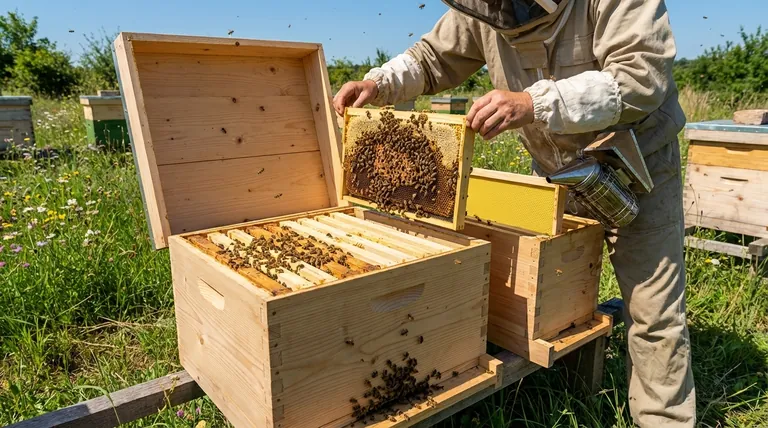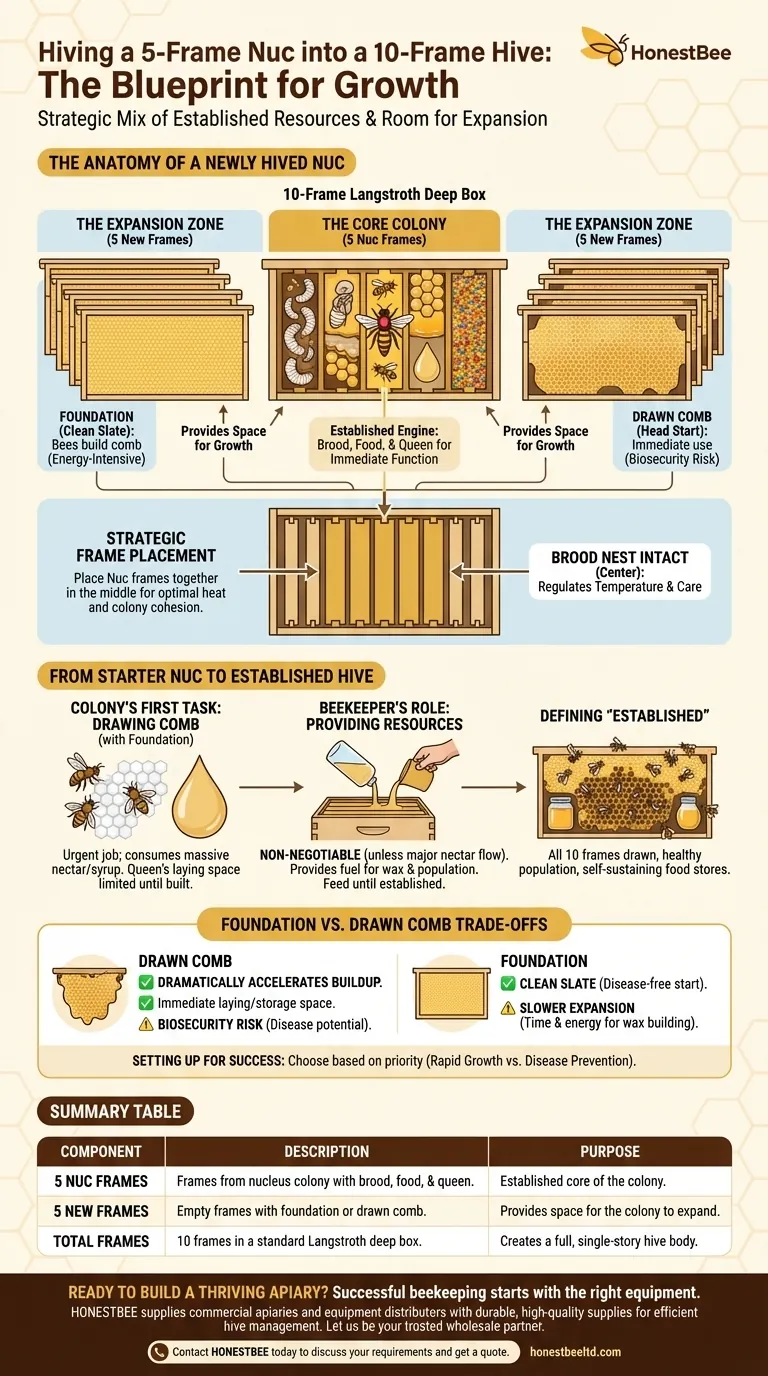At its core, a 10-frame hive that has just received a 5-frame nucleus colony (nuc) is a strategic mix of established resources and room for growth. The hive will contain the five fully active frames from the nuc, placed alongside five new, empty frames that the bees must build out.
The goal is not simply to fill the box, but to arrange the components in a way that encourages the small, potent colony to expand efficiently into a full, self-sustaining hive.

The Anatomy of a Newly Hived Nuc
Transferring a nuc is about transplanting the heart of a colony. The initial setup is designed to protect this core while providing a clear path for expansion.
The Core Colony (The Nuc Frames)
The five frames from the nuc are the engine of your new hive. They are not empty; they are a functioning, miniature colony.
These frames contain a balanced mix of brood (eggs, larvae, and pupae), honey and pollen stores, and, most importantly, the laying queen. This existing structure allows the colony to function and grow from day one.
The Expansion Zone (The New Frames)
The five additional frames provide the necessary space for the colony to grow. These are typically frames with either foundation or drawn comb.
Foundation is a sheet of beeswax or plastic imprinted with the shape of honeycomb cells. The bees use this as a guide to build new comb.
Drawn comb is foundation that bees have already built out into full-depth honeycomb cells. Using drawn comb gives the colony a significant head start.
Strategic Frame Placement
The arrangement of frames is critical. The five nuc frames should be placed together, in the center of the 10-frame box.
This keeps the brood nest intact and consolidated, making it easier for the bees to regulate temperature and care for the young. The new, empty frames are then placed on either side of this central cluster.
From Starter Nuc to Established Hive
Once hived, the colony's primary focus shifts from maintenance to aggressive expansion. Your role is to provide the resources they need to succeed.
The Colony's First Task: Drawing Comb
If you provided frames with foundation, the bees' most urgent and energy-intensive job is to "draw out" the comb. They must produce beeswax from their own bodies to build the honeycomb structure.
This process consumes a massive amount of nectar or sugar syrup. Until this comb is built, the queen has limited space to lay new eggs and workers have nowhere to store incoming nectar and pollen.
The Beekeeper's Role: Providing Resources
You must feed the new hive with sugar syrup. This is non-negotiable unless you are in the middle of a major, sustained nectar flow.
Feeding provides the raw fuel the bees need to produce wax, draw out the new frames, and feed the growing population. Continue feeding until the colony becomes fully established.
Defining "Established"
A hive is considered established when it has successfully drawn out the comb on all ten frames.
At this point, the hive should also have a healthy population and enough stored honey and pollen to sustain itself without supplemental feeding.
Understanding the Trade-offs: Foundation vs. Drawn Comb
The choice between providing foundation or fully drawn comb involves a significant trade-off between speed and biosecurity.
Using Drawn Comb: The Head Start
Providing drawn comb is like giving the colony a fully furnished home. The queen can begin laying in the empty cells immediately, and foragers can store resources without delay.
This dramatically accelerates colony buildup. However, old comb from an unknown source can potentially carry diseases like American Foulbrood spores. Only use clean comb from your own healthy hives.
Using Foundation: The Clean Slate
Starting with fresh foundation ensures the hive is completely clean and free of any potential legacy pathogens. The bees build fresh, perfect comb tailored to their needs.
The downside is the significant cost in time and resources. The colony's expansion will be slower as they must first build their own infrastructure before they can truly expand the population and store surplus honey.
Setting Your New Hive Up for Success
Your initial setup choices directly influence the trajectory of the colony for the entire season.
- If your primary focus is rapid population growth: Use clean, drawn comb if it is available and feed consistently to fuel the queen's laying and population expansion.
- If your primary focus is disease prevention and a clean start: Use new foundation and be prepared to feed the hive heavily until all ten frames are fully drawn out.
Properly installing and supporting your nuc lays the foundation for a productive and thriving colony.
Summary Table:
| Component | Description | Purpose |
|---|---|---|
| 5 Nuc Frames | Frames from the nucleus colony, containing brood, food, and the queen. | The established core of the colony. |
| 5 New Frames | Empty frames with foundation or drawn comb. | Provides space for the colony to expand. |
| Total Frames | 10 frames in a standard Langstroth deep box. | Creates a full, single-story hive body. |
Ready to build a thriving apiary?
Successful beekeeping starts with the right equipment. At HONESTBEE, we supply commercial apiaries and equipment distributors with the durable, high-quality supplies needed for efficient hive management and expansion.
Let us be your trusted wholesale partner for all your beekeeping needs.
Contact HONESTBEE today to discuss your requirements and get a quote.
Visual Guide

Related Products
- 5 Frame Wooden Nuc Box for Beekeeping
- Plastic Transporting Bee Packages and Nuc Boxes for Beekeeping
- Portable Bee Mating Hive Boxes Mini Mating Nucs 8 Frames for Queen Rearing
- HONESTBEE Professional Multi-Functional Hive Tool with Ergonomic Wood Handle
- HONESTBEE Professional Long Handled Hive Tool with Precision Cutting Blade
People Also Ask
- What frames should be moved into the queenless hive when requeening with a nuc? Ensure a Successful Queen Introduction
- What are the benefits of using nucs for beginning beekeepers? Ensure a Successful First Hive with a Head Start
- How many frames does a typical wooden nuc box hold? A Guide to Choosing the Right Size
- What is the advantage of overwintering a nucleus? A Strategic Asset for Beekeeping Success
- How should the nuc be installed in the apiary? Ensure Colony Success from Day One



















